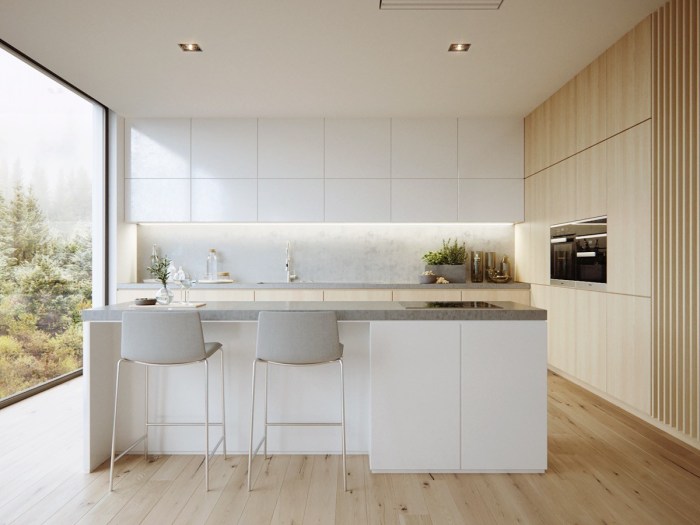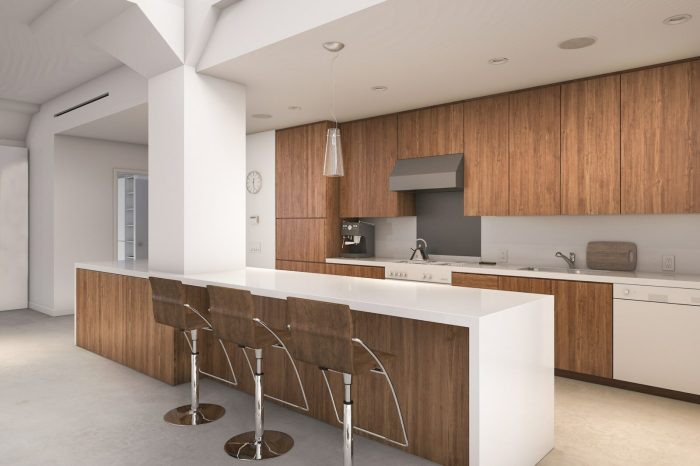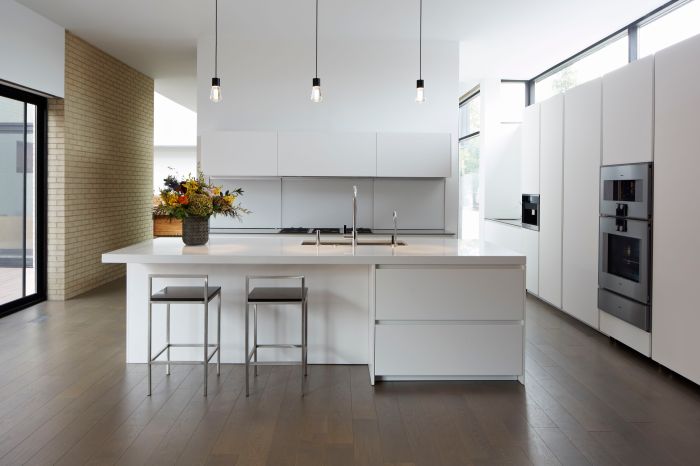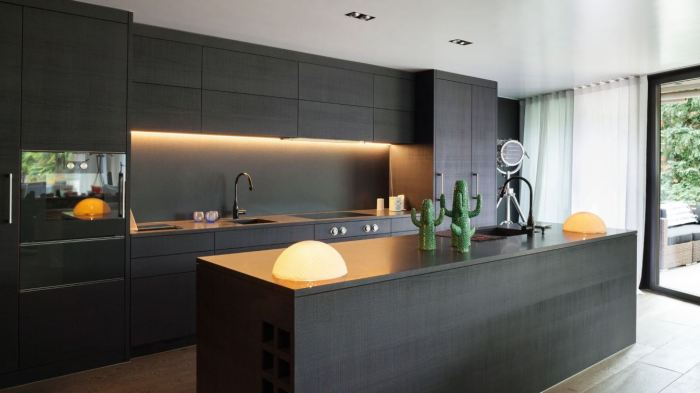The minimalist aesthetic, characterized by its clean lines and uncluttered spaces, finds a harmonious partner in the warm, natural beauty of wood. This design approach transcends mere visual appeal; it’s a carefully orchestrated balance of form and function, where every element serves a purpose and contributes to a sense of calm and serenity. We delve into the principles of minimalist kitchen design, exploring how the strategic use of wood tones can elevate this style, creating a space that is both visually stunning and remarkably practical.
The journey will encompass material selection, color palettes, lighting strategies, and innovative storage solutions, all aimed at crafting a minimalist kitchen that reflects both modern sensibilities and the enduring appeal of natural materials.
From the careful selection of wood species – oak, walnut, maple, each with its unique grain and color profile – to the strategic placement of lighting to accentuate the textures and shadows, we will examine the nuances that transform a simple kitchen into a haven of minimalist elegance. We’ll consider the interplay of light and dark wood tones, the impact of grain patterns, and how these choices influence the overall mood and atmosphere of the space.
The design process will be detailed, incorporating practical considerations such as cabinet dimensions, storage optimization, and the seamless integration of essential appliances.
Defining the Minimalist Aesthetic in Kitchen Design

Minimalist kitchen design prioritizes functionality and visual serenity by employing a restrained approach to elements and decoration. This aesthetic, rooted in the broader minimalist philosophy, seeks to achieve maximum impact with minimal means, creating a space that is both efficient and calming. The core principles translate directly into tangible design choices, resulting in a kitchen that feels spacious, uncluttered, and effortlessly stylish.Core Principles of Minimalist Kitchen DesignMinimalist kitchen design is characterized by a few key principles.
First, it emphasizes simplicity and functionality. Every item in the kitchen serves a clear purpose; there is no space for unnecessary clutter or decorative items that don’t contribute to the overall functionality or aesthetic. Second, a restrained color palette is crucial. Typically, minimalist kitchens feature a neutral base, often incorporating shades of white, gray, or beige, which are then accented with one or two other carefully chosen colors.
This limited palette creates a sense of calm and spaciousness. Third, clean lines and uncluttered surfaces are paramount. Cabinetry, countertops, and appliances should have simple, unadorned designs, avoiding ornate details or excessive embellishments.The Role of Negative Space in Creating a Minimalist FeelNegative space, or the empty space surrounding objects, is a critical component of minimalist design. In a minimalist kitchen, ample negative space creates a sense of openness and airiness.
The strategic use of negative space allows the eye to rest and appreciate the carefully chosen elements within the design. For example, leaving a significant portion of a countertop uncluttered, or choosing a kitchen island with ample legroom around it, significantly contributes to the feeling of spaciousness. The deliberate absence of visual distractions enhances the overall aesthetic impact of the few, carefully selected items.
This is a fundamental principle of minimalist design – less is more.Balancing Simplicity with Functionality in a Minimalist KitchenThe challenge in minimalist kitchen design lies in balancing the aesthetic of simplicity with the practical needs of a functional workspace. This requires careful planning and selection of high-quality, multi-purpose items. For instance, a well-designed kitchen island can serve as a preparation area, a dining space, and additional storage.
Multifunctional appliances, such as a combination microwave-oven or a slow cooker that also functions as a rice cooker, help reduce the number of individual appliances required. Clever storage solutions, like built-in drawers and cabinets, maximize space utilization while maintaining a clean, uncluttered look. The key is to thoughtfully curate each item, ensuring both its aesthetic appeal and its practical contribution to the kitchen’s functionality.Examples of Minimalist Design Elements Suitable for a KitchenMinimalist kitchens often feature sleek, handleless cabinets, creating a seamless, uncluttered look.
Integrated appliances, seamlessly blending into the cabinetry, further contribute to this clean aesthetic. Natural materials, such as wood and stone, are frequently used for countertops and backsplashes, introducing warmth and texture without overwhelming the minimalist design. Simple, geometric lighting fixtures, such as pendant lights or recessed lighting, provide functional illumination while maintaining the clean lines of the space.
A single, statement piece, such as a sculptural vase or a piece of art, can be incorporated to add a touch of personality without compromising the overall minimalist aesthetic. The careful selection and placement of these elements are key to achieving a balanced and harmonious kitchen design.
Exploring the Use of Wood Tones in Minimalist Kitchens
The minimalist aesthetic, characterized by its clean lines and uncluttered spaces, finds a harmonious partner in the warmth and natural beauty of wood. The strategic integration of wood tones can elevate a minimalist kitchen from stark to sophisticated, adding depth and texture without compromising the core principles of the design philosophy. The choice of wood, its tone, and grain pattern all contribute significantly to the overall ambiance.
Suitable Wood Types for Minimalist Kitchen Cabinetry and Countertops
The selection of wood for a minimalist kitchen hinges on durability, aesthetic appeal, and maintenance requirements. Hardwoods, known for their density and resistance to scratches and dents, are generally preferred for high-traffic areas like countertops and cabinetry. Examples include oak, known for its strength and varied grain patterns; walnut, prized for its rich, dark color and luxurious feel; and maple, appreciated for its clean, light color and fine grain.
Engineered woods, like plywood or medium-density fiberboard (MDF), offer cost-effective alternatives, often used as a base for veneer finishes that mimic the appearance of solid hardwoods. The choice depends on budget and desired level of maintenance. Solid wood requires more care, while engineered options offer greater ease of upkeep.
Light and Dark Wood Tones in Minimalist Settings: A Comparison
Light wood tones, such as those found in ash, birch, or light oak, create a sense of spaciousness and brightness, ideal for smaller kitchens or those with limited natural light. They enhance the minimalist aesthetic’s emphasis on clean lines and open spaces, creating a feeling of airy lightness. Conversely, dark wood tones, like those in walnut or ebony, bring a sense of sophistication and drama.
Used judiciously, they can ground the space and create a focal point, particularly effective in larger kitchens where a bolder statement is desired. The contrast between light and dark wood can also be employed strategically; for instance, light cabinetry paired with a dark wood countertop or island. This contrast provides visual interest without sacrificing the minimalist principles of simplicity and balance.
Influence of Wood Grain Patterns on Minimalist Kitchen Aesthetics
The wood grain pattern significantly influences the visual texture and appeal of a minimalist kitchen. Fine, subtle grains, like those in maple or birch, contribute to a clean and uncluttered look, aligning perfectly with the minimalist philosophy. They create a smooth, understated elegance. Conversely, more pronounced grain patterns, such as those in oak or walnut, add visual interest and texture, offering a more rustic or traditional feel, which can still complement a minimalist design when used thoughtfully.
The choice depends on the desired level of visual complexity; a subtle grain enhances the clean lines, while a bolder grain adds a layer of visual richness.
Minimalist Kitchen Color Palettes Incorporating Wood Tones
Three distinct color palettes showcasing the versatility of wood tones in minimalist kitchens are presented below.
- Palette 1: Warm Neutrals: Light oak cabinetry paired with a creamy white backsplash and countertops. Accents of warm beige and muted gold add depth without overwhelming the space. This palette evokes a sense of calm and understated elegance.
- Palette 2: Cool Monochromes: Dark walnut cabinetry contrasted with a cool gray backsplash and white countertops. Accents of charcoal gray and black add sophistication and visual weight. This palette creates a modern, sleek, and dramatic atmosphere.
- Palette 3: Earthy Tones: Medium-toned cherry cabinetry combined with a light beige backsplash and off-white countertops. Accents of sage green and terracotta bring a touch of nature-inspired warmth. This palette offers a balance between rustic charm and modern minimalism.
Cabinetry and Storage Solutions for a Minimalist Wood Kitchen
The design of cabinetry and storage significantly impacts the functionality and aesthetic appeal of a minimalist wood kitchen. Careful consideration of dimensions, materials, and innovative storage solutions is crucial for maximizing space and maintaining a clean, uncluttered look. The principles of minimalism emphasize functionality and efficiency, requiring a strategic approach to storage that integrates seamlessly with the overall design.
Minimalist Wood Cabinet Design Specifications
A minimalist kitchen design often favors clean lines and simple forms. For a wood kitchen, consider using light-colored, sustainably sourced hardwoods like ash or maple for a bright, airy feel, or darker woods such as walnut or cherry for a more dramatic effect. Cabinets should be flush-mounted, handleless, and feature integrated push-to-open mechanisms to maintain a sleek, uncluttered look.
Standard cabinet depths of 24 inches are suitable, with upper cabinets measuring approximately 30-36 inches high and lower cabinets around 34-36 inches high. Cabinet widths can vary depending on available space, but maintaining consistent widths across the kitchen creates a sense of visual harmony. For example, a common configuration might use 36-inch wide base cabinets and 18-inch wide upper cabinets, allowing for versatile arrangement.
The use of high-quality, durable finishes, such as a matte lacquer or a low-VOC oil-based stain, is important for both aesthetics and longevity. Internal cabinet organization should prioritize functionality; adjustable shelving is crucial for accommodating items of varying heights.
Maximizing Space with Efficient Storage Solutions
Efficient storage is paramount in a minimalist kitchen. The design should focus on maximizing vertical space and utilizing often-overlooked areas. Deep drawers are superior to traditional cabinets for accessibility, allowing for full visibility of contents. Pull-out pantry systems, with adjustable shelves and dividers, offer excellent organization for dry goods. Corner units can be optimized with clever rotating or pull-out shelves to eliminate wasted space.
Consider installing a narrow spice rack on the inside of a cabinet door or utilizing the space under the sink with pull-out drawers designed specifically for cleaning supplies. A well-planned storage system minimizes clutter and enhances the overall efficiency of the kitchen.
Innovative Space-Saving Storage Ideas
Innovative storage solutions further enhance the functionality of a minimalist kitchen. Magnetic knife strips affixed to the backsplash or a side wall provide easy access to knives while saving counter space. A vertical utensil organizer, slim enough to fit within a drawer, keeps utensils readily accessible and neatly arranged. Stackable, airtight containers for food storage optimize space and maintain freshness.
For cookware, consider a pot rack mounted to the ceiling or wall, freeing up valuable cabinet space. Using drawer dividers and organizers, custom-fitted for specific items, prevents shifting and keeps everything in its place. Employing these innovative solutions promotes a clean and organized workspace.
Essential Kitchen Appliances and Seamless Integration
Selecting and integrating essential appliances is key to maintaining a minimalist aesthetic. Prioritize appliances with clean lines and a streamlined design that complements the overall style of the kitchen. Built-in appliances, such as a refrigerator, oven, and dishwasher, are ideal for a seamless look. A minimalist approach often involves choosing appliances with multiple functions to reduce the number of individual units needed.
For example, a combination microwave-oven or a slow cooker/pressure cooker could significantly reduce the number of appliances, maximizing space and preserving the clean, uncluttered feel of a minimalist kitchen. Careful consideration of placement and the selection of appliances that match the color palette of the cabinets and countertops further enhances the cohesive design.
Lighting and Decor in a Minimalist Wood Kitchen

The interplay of light and carefully chosen décor is crucial in achieving the serene and functional atmosphere characteristic of a minimalist wood kitchen. Effective lighting design not only illuminates the space but also enhances the natural beauty of the wood, creating a warm and inviting ambiance. Similarly, minimalist décor elements, used judiciously, complement the wood tones, avoiding visual clutter and maintaining the clean lines of the design.
Ambient, Task, and Accent Lighting Schemes
A well-designed lighting scheme for a minimalist wood kitchen integrates three key types of lighting: ambient, task, and accent. Ambient lighting provides overall illumination, typically achieved through recessed ceiling lights or a central pendant light. These should emit a soft, warm white light (around 2700-3000 Kelvin), mimicking natural daylight and complementing the wood’s warmth. Task lighting, on the other hand, focuses on specific areas where activities occur, such as above the cooking range or the kitchen island.
Under-cabinet lighting, using LED strips for energy efficiency, is ideal for task lighting, providing bright, focused illumination without disrupting the overall minimalist aesthetic. Accent lighting highlights architectural features or decorative elements. This could involve strategically placed spotlights to draw attention to a textured wall or a piece of art. The balance between these three types of lighting is key to creating a versatile and functional space.
Minimalist Décor Elements Complementing Wood Tones
Minimalist décor in a wood kitchen emphasizes simplicity and functionality. A few carefully selected items can significantly enhance the space without overwhelming it. Examples include a single, statement piece of art featuring clean lines and muted colors, a sleek ceramic vase with a few dried branches, or a sculptural bowl made of natural materials like stone or ceramic.
These elements add visual interest while maintaining the clean, uncluttered aesthetic of the minimalist design. The color palette should be cohesive, using neutral tones that complement the wood’s natural hues. Think creamy whites, soft grays, or muted greens – colors that evoke a sense of calm and tranquility.
Incorporating Natural Light to Enhance Minimalist Aesthetics
Natural light is a powerful tool in enhancing the minimalist aesthetic. Maximizing natural light influx brightens the space, highlighting the texture and grain of the wood. Large windows or skylights, if possible, are ideal. Sheer curtains or blinds can be used to control the amount of light entering the room and to diffuse harsh sunlight. The strategic placement of mirrors can also help reflect natural light deeper into the kitchen, creating a brighter and more spacious feel.
This approach not only enhances the visual appeal but also reduces the reliance on artificial lighting, contributing to energy efficiency.
Texture and Pattern Beyond Wood
While wood provides the primary textural element, incorporating other textures and subtle patterns adds depth and visual interest without disrupting the minimalist aesthetic. Consider using a honed or brushed stone countertop for a smooth, matte finish that contrasts with the wood’s grain. A textured linen or cotton fabric for kitchen towels or a simple, geometric patterned rug can introduce subtle visual interest without overwhelming the space.
The key is to maintain a cohesive color palette and to limit the number of patterns and textures to avoid creating a cluttered or busy feel. For instance, a single, subtly patterned backsplash tile can add visual complexity without detracting from the overall minimalist feel.
Visual Representation

A minimalist kitchen with wood tones presents a harmonious blend of functionality and aesthetic appeal. The inherent warmth of wood complements the clean lines and uncluttered surfaces characteristic of minimalist design, creating a space that is both visually calming and highly efficient. Careful selection of materials, colors, and layout are crucial in achieving this balance.
The following table details the material choices and color palettes for a successful minimalist wood-toned kitchen design. These selections are informed by principles of visual psychology and the practical considerations of durability and ease of maintenance within a high-traffic area.
Minimalist Kitchen Material Specifications
| Element | Material | Color | Description |
|---|---|---|---|
| Cabinets | Solid Oak | Light Honey | The light honey oak provides a warm base, avoiding any visual heaviness often associated with darker woods. The solid wood offers superior durability compared to alternatives. |
| Countertops | White Quartz | Off-White | Quartz offers exceptional durability and stain resistance, vital in a kitchen environment. The off-white color creates a clean contrast to the wood tones, enhancing the minimalist aesthetic. |
| Backsplash | Large Format Matte White Tiles | Bright White | Large format tiles minimize grout lines, contributing to the clean, uncluttered look. Matte finish reduces glare and reflects light softly. |
| Flooring | Light Gray Engineered Wood | Light Gray | Engineered wood provides stability and durability, suitable for high-traffic areas. The light gray complements the wood cabinets and quartz countertops without competing visually. |
Minimalist Kitchen Island Design
The kitchen island serves as a central focal point, demanding careful consideration of its design elements. The following design choices maximize functionality and visual appeal within the minimalist aesthetic.
The island features a substantial, single piece of solid oak for the countertop, extending its warmth and natural grain throughout the space. This emphasizes the natural beauty of the material and reduces visual clutter.
Minimalist storage is achieved through a combination of integrated drawers and concealed shelving within the island’s base. Handles are recessed or absent, maintaining a seamless, clean look.
The island’s legs are simple, slender, and crafted from the same light honey oak as the cabinets, creating visual unity.
Minimalist Kitchen Backsplash Styles
The backsplash plays a significant role in shaping the overall aesthetic of a minimalist kitchen. Three distinct styles effectively complement wood tones while adhering to minimalist principles.
- Large Format Matte White Tiles:
- Pros: Clean, modern look; minimizes grout lines; easy to clean; reflects light effectively.
- Cons: Can be expensive; requires careful installation to avoid imperfections.
- Subtle Linear Patterned Tiles:
- Pros: Adds subtle texture and visual interest without overwhelming the space; complements wood tones effectively.
- Cons: Requires careful selection to avoid clashing with the overall color scheme; grout lines may require more attention.
- Solid Color Painted Backsplash:
- Pros: Cost-effective; allows for easy color customization; creates a seamless, clean look.
- Cons: Less durable than tile; requires more maintenance; may show scratches or stains more easily.
Final Summary

Ultimately, the minimalist kitchen with wood tones represents a sophisticated fusion of modern design principles and the timeless appeal of natural materials. By thoughtfully considering the interplay of negative space, carefully chosen wood types, strategic lighting, and efficient storage solutions, one can create a kitchen that is not only visually striking but also incredibly functional and conducive to a peaceful, organized lifestyle.
The journey from concept to completion involves a series of considered choices, each contributing to the overall aesthetic and practical success of the design. The result is a space that exudes both style and functionality, a testament to the power of mindful design.
Popular Questions
What are the best wood sealants for a minimalist kitchen?
Hardwearing, food-safe sealants like polyurethane or mineral oil are ideal, offering protection against moisture and stains while maintaining the wood’s natural appearance.
How can I prevent a wood kitchen from feeling too dark?
Incorporate ample natural light, use lighter wood tones, and strategically place mirrors to reflect light and create a sense of spaciousness.
What are some low-maintenance countertop options that complement wood cabinets?
Quartz and engineered stone are excellent choices, offering durability and easy cleaning while providing a beautiful contrast or complement to wood.
How do I maintain the wood in my minimalist kitchen?
Regular dusting and occasional cleaning with a damp cloth are usually sufficient. Avoid harsh chemicals and use a wood-specific cleaner if necessary. Periodically apply sealant to maintain protection.
Are open shelves suitable for a minimalist wood kitchen?
Yes, but careful curation is key. Display only essential and aesthetically pleasing items to maintain the minimalist aesthetic. Consider using uniform containers to maintain visual order.